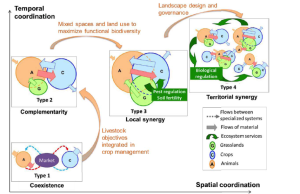Different types of integration
The level of temporal and spatial coordination allows to define 4 main generic types of crop-livestock integration.
Type 1 represents a situation of non-integration, i.e. a simple coexistence of specialized farms which can exchange products on the market (e.g. buying feed).
Type 2 is the first step of integration. There are exchanges between crops, grasslands and animals (feed, straw, manure...) by means of the integration of livestock objectives in crop choice (e.g. silage maize) and management (e.g. organic fertilization).
Type 3 shows a stronger interaction between the different spheres which generate local synergies at the farm scale: for instance, the grasslands in rotation with crops, the introduction of legumes and/or intercropping have a positive effect on biodiversity, leading to ecosystemic services related with pest regulations and soil fertility.
Type 4 is achieved when several farms of type 3 interact at the territorial level through landscape design and territorial governance.
This typology allows us to characterize the integration at the farm level. The proportion of each type at the territorial scale can provide a characterization of the level of integration of the studied territory.
